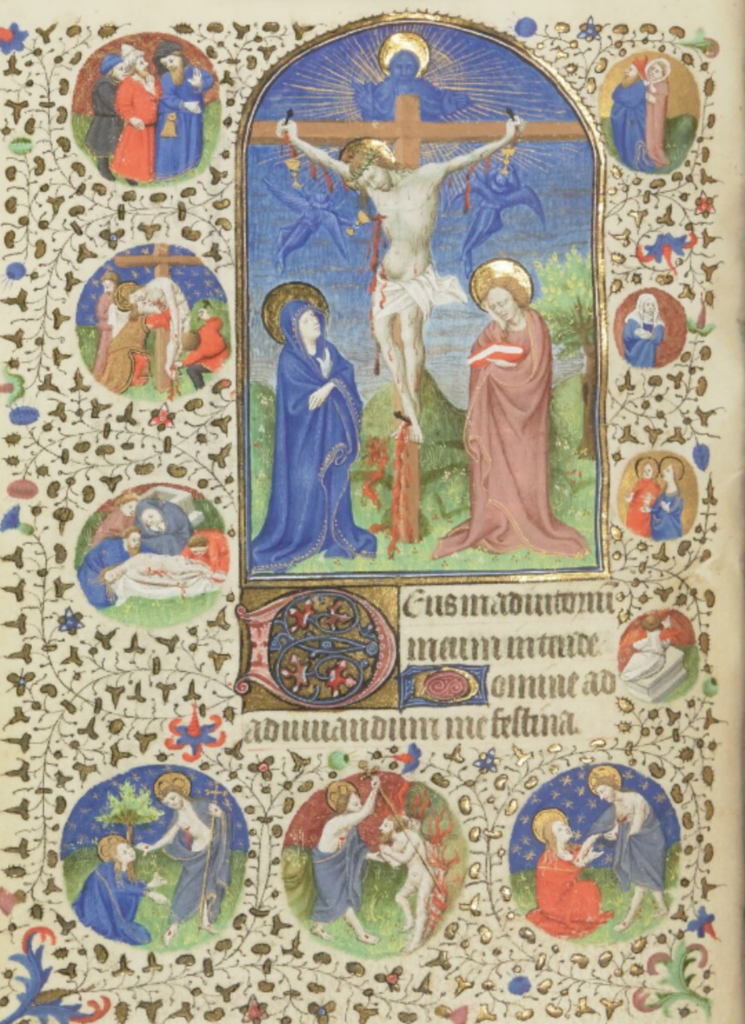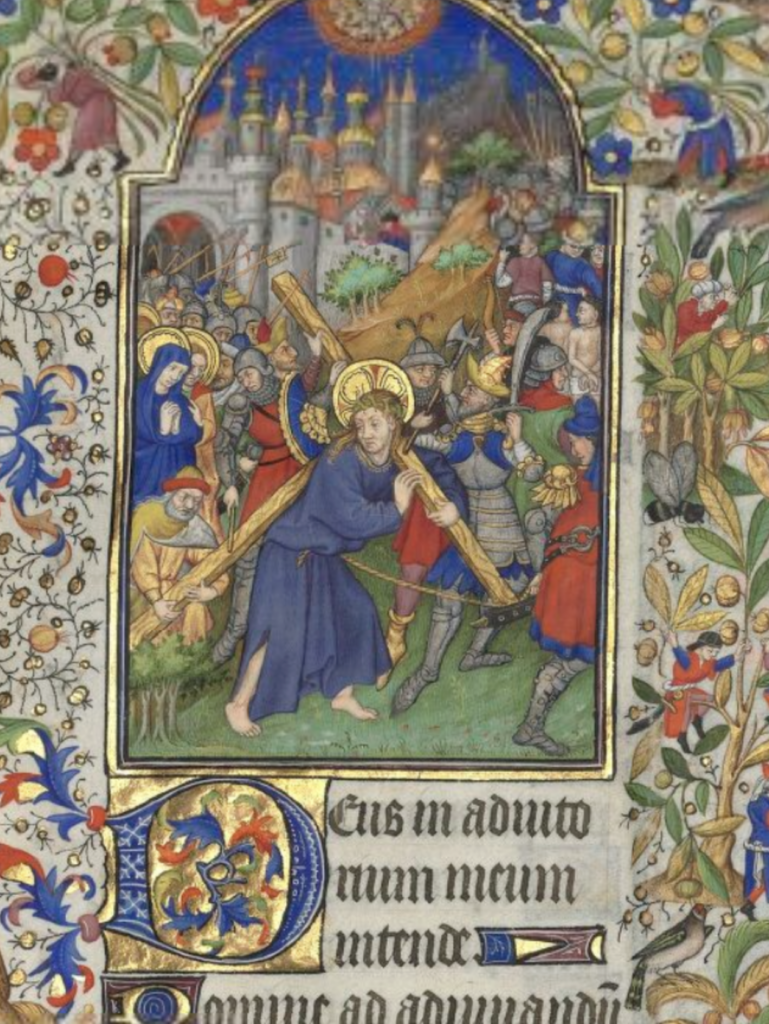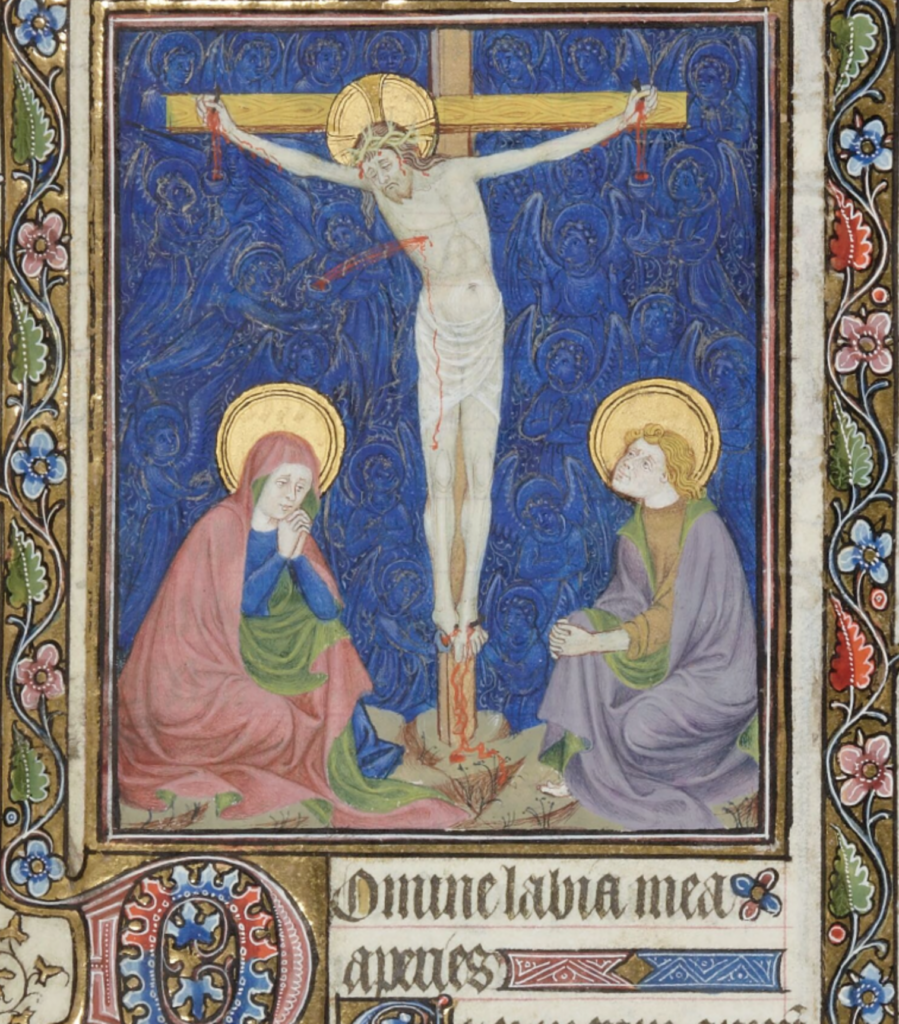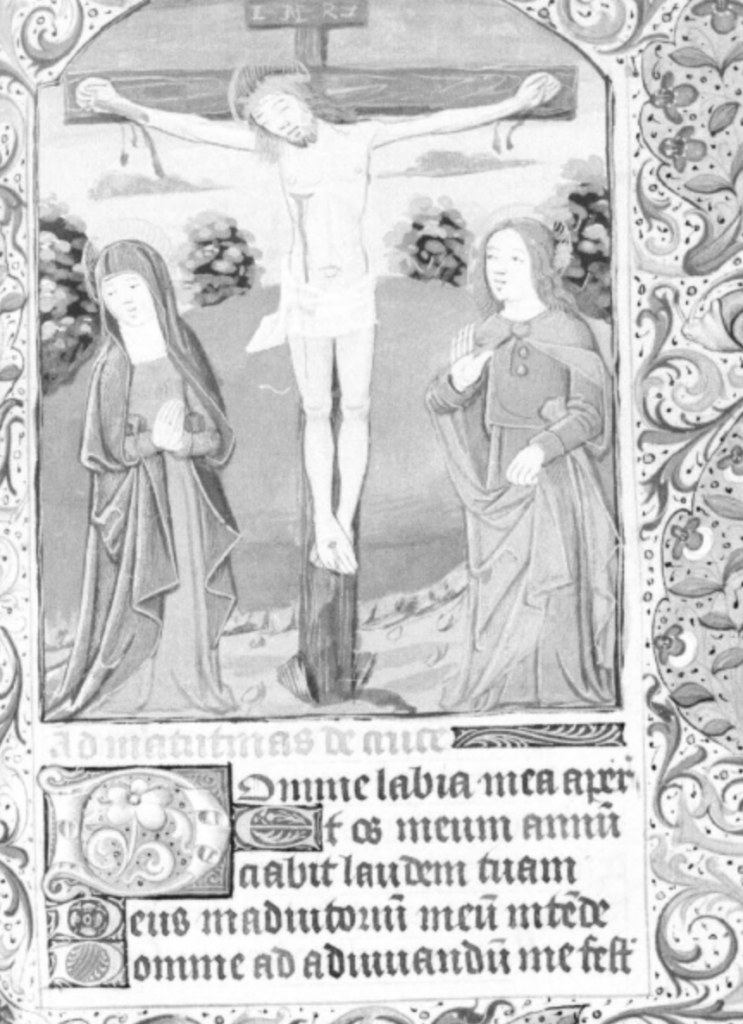While doing research on Saint-Chappelle in the Fall of 2023, my team and I noted that The Crown of Thorns was ritualized and fanaticized as one of the Sainte-Chapelle relics, with Louis IX dedicating a Feast Day to its prowess (Aug. 11th). The people of Paris even had the chance to see Louis IX cosplay as Jesus, as he adorned the relic on top of his head. Therefore, we know that The Crown of Thorns was a big deal in Paris and for French royalty as a symbol of power. However, its depiction and meaning in Parisian Books of Hours remain a fascinating inquiry.
As far as I can tell, there are no prayers specifically for the Crown of Thorns in Parisian Books of Hours. Instead, the Crown of Thorns shows up solely in textual and artistic depictions of Jesus’s crucifixion. Most Books of Hours feature a section called The Hours of the Cross, which follows the events of Christ’s crucifixion. Each hour within this section focuses on a sequential moment associated with Christ’s passion. The Crown of Thorns is usually referenced during Terce – part of the seven canonical hours, Terce was to be recited at nine in the morning – in the Hymn:
Crucifige clamitant hora tertiarum:
Illusus induitur veste purpurarum:
Caput eius pungitur corona spinarum.
Crucem portat humeris ad locum poenarum.At the third hour of the day they crucify him cry,
In a purple robe clad him more to mock thereby,
Piteously his head was pricked with the crown of thorn,
To the place of pain his cross was on his shoulders born.(transl. Glenn Gunhouse, Hypertext Book of Hours).
Likewise, artistic depictions of Jesus wearing the Crown of Thorns are found in miniatures throughout the Hours of the Cross. Typically, these miniatures are situated at the onset of the Hours of Cross before Matins – the first of the canonical hours, recited in the early hours of the morning. They commonly feature Jesus on the Cross, wearing the Crown of Thorns, flanked by the Virgin Mary and John the Evangelist in prayer. Here’s a prime illustration of this:
Similar examples can be found in other Books of Hours, where, as in Figure One, each miniature preceding Matins depicts Jesus crucified, wearing the Crown of Thorns. However, there are variations on this pattern. For instance, in Bibliothèque Nationale de France, MS lat. 1183, alongside Jesus are the two thieves who were crucified with him. One is depicted with a hunched back, while the other appears to be smiling peacefully, representing their contrasting beliefs in Jesus’s deity. Likewise, on the right side, there is a figure resembling a Rabbi and two other men. While their identities may not be explicitly stated, their presence signifies witnesses or bystanders to the crucifixion scene, likely contrasting between figures representing religious and secular authority.
Other examples are seen below:
Within different Books of Hours, however, the placement and interpretation of miniatures can differ. In Bibliothèque Nationale de France, MS lat. 919, there’s a similar miniature to Figure 1, but it’s placed in Terce, aligning with the text about the Crown of Thorns in the Hours of the Cross. Similarly, Bibliothèque Nationale de France, MS lat. 1158 also features a miniature that is located in Matins, but has roundels in the borders that correspond to specific moments in the story of Jesus’s passion:

Bibliothèque Nationale de France, MS lat. 1158 f. 120v, 15th Century, Use of Paris. Owned by Ralph Neville and Joan Beaufort.
But what makes MS lat. 1158 so special is that it was owned by Ralph Neville and Joan Beaufort, who were English aristocrats. Like me, you may be wondering why Neville and Beaufort owned a Parisian Book of Hours? This is where things get interesting, so you should probably fasten your seatbelt.
Ralph Neville’s brother-in-law was Henry Bolingbroke, a.k.a King Henry IV of England whose grandfather, King Edward III, started the 100 Years’ War (1337-1453). And this is where it gets confusing, so let’s break it down. The Hundred Years’ War was a century-long tug-of-war between England and France, fueled by power struggles, territorial ambitions, and a whole lot of ego. It started in 1337 when King Edward III of England decided he wanted a piece of the French throne. What followed was a rollercoaster of battles, alliances, and betrayals that left ordinary folks caught in the crossfire. But wait, there’s more! In the midst of all this chaos, you’ve got the Burgundian and Orlean parties stirring up trouble within France itself, like rival cliques in a high school cafeteria. Talk about adding fuel to the fire! Despite moments of courage and heroism, the war brought devastation to both sides. But eventually, after a hundred years of fighting, England and France managed to patch things up (sort of) and civilly sit across from each other at the dining table during holidays (Curry 2002).
But what this means is that Ralph Neville and Joan Beaufort were probably part of the English occupation of France during this time, which correlates to why an English aristocratic family owns a Parisian Book of Hours.The portrayal of the Crown of Thorns in their prayerbook is quite typical of what you would find in a “standard” Parisian Book of Hours owned by non-aristocratic French individuals. Books of Hours owned by French aristocrats during this time, on the other hand, featured many nuanced and varied portrayals of Christ with the Crown of Thorns.
For example, in a Parisian Book of Hours owned by René d’Anjou (1434-1480), the King of Sicily, there is a miniature depicting Jesus being carried by an Angel, featuring the Arma Christi (The Instruments of Passion) displayed on the Cross behind them. These instruments typically include whips, the nails that pinned Christ to the Cross, the lance that pierced his side, and a sponge full of vinegar for him to drink. In the early Middle Ages, the Arma Christi began to symbolize Jesus’s triumph over death. This is interesting, as René d’Anjou paints Jesus as a royal figure in a prayer on folio 147 in BNF MS. lat 1156A, suggesting that René compares himself to Jesus, as Jesus was a good king who was betrayed. René himself supported the French Crown during the 100 Year War, thus leading him to lose his title of Duke of Anjou to Antoine de Vaudemont, who was backed by the Burgundian Party. To an extent, the Arma Christi may have been used to signify that even though like Jesus, René lost, he still triumphed over his betrayers, and will be carried to Heaven by an Angel.

Bibliothèque Nationale de France, MS lat. 1156A f. 82r, 15th Century, Use of Paris. Owned by René De Anjou.
By the same token, in a Book of Hours, BNF MS lat. 1156B, owned by Marguerite d’Orléans, wife of Richard, Count of Etampes, there are three miniatures of Jesus wearing the Crown of Thorns. In this particular Book of Hours, the three miniatures feature Jesus wearing the Crown of Thorns each correspond to a different section: Terce, Sext, and None.

Bibliothèque Nationale de France, MS lat. 1156B f. 137r, 15th Century, Use of Paris. Owned by Marguerite d’Orléans, wife of Richard, Count of Etampes
Jesus is depicted wearing the Crown of Thorns while carrying the cross through Jerusalem, with crowds accompanying him. Among the onlookers are important figures such as the Virgin Mary.
Jesus being nailed to the Cross, with onlookers, including the Virgin Mary, observing the solemn moment. In the background, the crosses of the two thieves are raised.
Jesus’s cross is raised, with the two thieves positioned on either side. On the left, the Virgin Mary is surrounded by additional figures, indicated by the golden halos surrounding their heads, while Roman soldiers and other figures observe from the right. Interestingly, on the left side, a Roman soldier is shown lancing Jesus’s side.
It’s noteworthy that none of these miniatures directly correspond with the content of their respective sections. Typically, Jesus on the Cross is associated with the Terce, making these deviations intriguing, although not necessarily important. What is more important is that similar to the owner’s of the two previous Books of Hours, Richard, Count of Etampes had an extremely sticky relationship with the 100 Years’ War. Richard had complex familial relationships (don’t we all) with France and England, and his own mother Joan was remarried to King Henry IV of England (Ralph Neville’s brother-in-law). Richard’s step-brother, King Henry V, would later invade France and reignite the 100 Year War. The abundance of imagery depicting the Crown of Thorns might indicate Marguerite and Richard’s allegiance to the French Crown, akin to René d’Anjou’s fluid miniature, which not only reflects his self-image but also his political convictions.
These differences from the miniatures found in other Books of Hours suggest that the portrayal and significance of Jesus wearing The Crown of Thorns could have varied among French royalty and their respective connections, especially during the 100 Years’ War. This is similar to how Sainte-Chappelle’s devotion to the Crown of Thorns was a political tool used by Louis IX and Blanche de Castille to expand the power of the French crown in the thirteenth Century. If anything, the Crown of Thorns was a political tool that symbolized the French Crown. Even in personal Books of Hours, the extent to which the Crown of Thorns was featured may have represented the political beliefs of aristocrat’s in France and England during the 100 Years’ War, with those allying with the French Crown, having a much more powerful and significant relationship to the Crown of Thorns. But the degree to which this influenced lower nobility, or those who owned “standard” Parisian Books of Hours, is unknown. Many “standard” Parisian Books of Hours featured the common image of Jesus on the Cross wearing the Crown of Thorns, with the Virgin Mary and John the Evangelist on either side. But what is known for sure is that French and English aristocrats were a messy bunch, with excessive amounts of family drama. More than I could handle, that’s for sure.
– Isa Davis
Bibliography
Work Cited
Curry, Anne. “The Hundred Years’ War 1337-1453.” Essential History. Osprey Publishing, 2002.
Hours of the Cross. “Terce.” Hypertext Book of Hours, Hours of the Cross, ed. and transl. Glenn Gunhouse. 2019. https://medievalist.net/hourstxt/spster.htm
Manuscripts Consulted
Bibliothèque Nationale de France, MS lat. 924
Bibliothèque Nationale de France, MS lat. 1183
Bibliothèque Nationale de France, MS lat. 1182
Bibliothèque Nationale de France, MS lat. 1168
Bibliothèque Nationale de France, MS lat. 1158





